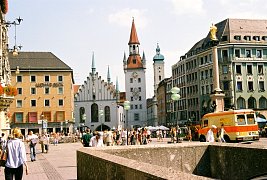 The tower located centrally in the background of this photo is the
Altes Rathaus (Old Town Hall) originally constructed between 1470-80.
It is the most easterly building on Marienplatz square. It
has a Gothic council hall and ballroom and the adjoining
town hall tower have been reconstructed after its destruction
during World War II.
The tower located centrally in the background of this photo is the
Altes Rathaus (Old Town Hall) originally constructed between 1470-80.
It is the most easterly building on Marienplatz square. It
has a Gothic council hall and ballroom and the adjoining
town hall tower have been reconstructed after its destruction
during World War II.
|
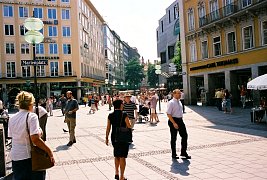 We are leaving the Marienplatz to find the local open air market -
the Viktualienmarkt.
We are leaving the Marienplatz to find the local open air market -
the Viktualienmarkt.
|
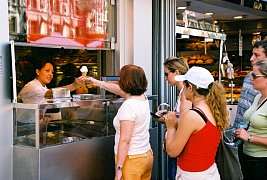
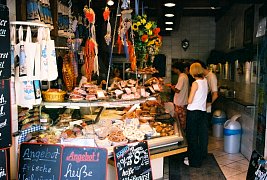 First we passed some small shops housed in permanent stalls.
The meat in the display counter (right) caught my eye.
I think the white rope of sausage is snowy veal Weisswurste.
Other typical big German sausage wursts are
coarse pork bratwurst, long thin Polnischer, and
pungent, rough-textured Regensburger.
First we passed some small shops housed in permanent stalls.
The meat in the display counter (right) caught my eye.
I think the white rope of sausage is snowy veal Weisswurste.
Other typical big German sausage wursts are
coarse pork bratwurst, long thin Polnischer, and
pungent, rough-textured Regensburger.
|
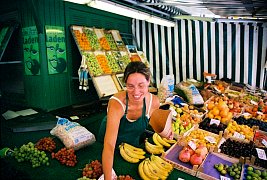 Since 1807 Munich Viktualienmarkt has sold fresh vegetables, fruits, cheeses, breads, flowers, herbs,
dried flowers, honey ladled out of hive-shaped vats, ham, salami, sausages, poultry, fresh
game, smoked fish, and wine.
Market workers and early shoppers breakfast at the many beer taverns, or Brauhaus, rimming
the marketplace to down powerful Munchener Weissbier - Munich white beer. They sip as they wait
for liver dumplings in broth, eggs scrambled with wurst and potatoes, or Beinfleisch, the
beloved local boiled beef.
This market is quite pricey, so you are better off doing your shopping in any of the other
smaller markets in the city, then coming here for that something you can't find anywhere else.
We returned here just before we left Munich to buy some flowers for our hosts.
Since 1807 Munich Viktualienmarkt has sold fresh vegetables, fruits, cheeses, breads, flowers, herbs,
dried flowers, honey ladled out of hive-shaped vats, ham, salami, sausages, poultry, fresh
game, smoked fish, and wine.
Market workers and early shoppers breakfast at the many beer taverns, or Brauhaus, rimming
the marketplace to down powerful Munchener Weissbier - Munich white beer. They sip as they wait
for liver dumplings in broth, eggs scrambled with wurst and potatoes, or Beinfleisch, the
beloved local boiled beef.
This market is quite pricey, so you are better off doing your shopping in any of the other
smaller markets in the city, then coming here for that something you can't find anywhere else.
We returned here just before we left Munich to buy some flowers for our hosts.
|
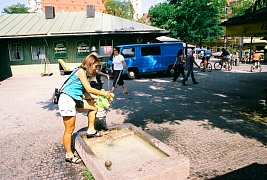 Margaret rinses off the green grapes we bought from
the young woman in the photo above.
Margaret rinses off the green grapes we bought from
the young woman in the photo above.
|
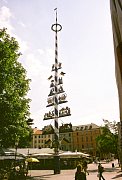
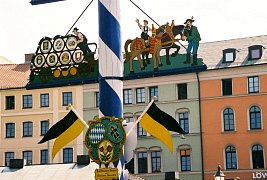
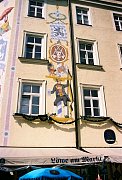 Here are examples of the Maypole (Maibaum) that seem to be found everywhere.
The picture in the middle shows a close up of the bottom of the pole shown
in the picture at the far left.
The set up of a Maypole is a Bavarian custom dating back to the
16th century.
Up to 40 m high, the Maypole is decorated with pictures of the main
buildings and the main crafts of the village.
An old tradition is to steal the Maypole before its setup by young
men of another village. To prevent this, the Maypole is guarded carefully.
To get back a stolen Maypole the payment is a barrel of beer and a good
meal (Brotzeit).
Since the late Middle Ages you find the custom of setting up small
Maypoles or Maybushes at the houses of girls by their lovers.
In front of inns (Gasthäuser) you also find both maypoles
and dancers dancing around them.
Maypoles are also associated with the festival of the Roman goddess
of spring, Flora, was celebrated from April 28 to May 3.
Here are examples of the Maypole (Maibaum) that seem to be found everywhere.
The picture in the middle shows a close up of the bottom of the pole shown
in the picture at the far left.
The set up of a Maypole is a Bavarian custom dating back to the
16th century.
Up to 40 m high, the Maypole is decorated with pictures of the main
buildings and the main crafts of the village.
An old tradition is to steal the Maypole before its setup by young
men of another village. To prevent this, the Maypole is guarded carefully.
To get back a stolen Maypole the payment is a barrel of beer and a good
meal (Brotzeit).
Since the late Middle Ages you find the custom of setting up small
Maypoles or Maybushes at the houses of girls by their lovers.
In front of inns (Gasthäuser) you also find both maypoles
and dancers dancing around them.
Maypoles are also associated with the festival of the Roman goddess
of spring, Flora, was celebrated from April 28 to May 3.
|
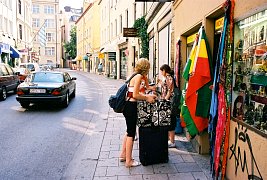
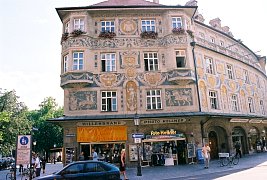 Now we are wandering around trying to find an electrical adapter
so we can recharge our camcorder. We bought a converter to convert from
the German and French voltages and frequencies but didn't anticipate
that we would need a small adapter to allow connection into the deep
round wall socket. The main electronics store didn't have what we
needed, but told us about another store "nearby". Here are some street
scenes along the way.
Now we are wandering around trying to find an electrical adapter
so we can recharge our camcorder. We bought a converter to convert from
the German and French voltages and frequencies but didn't anticipate
that we would need a small adapter to allow connection into the deep
round wall socket. The main electronics store didn't have what we
needed, but told us about another store "nearby". Here are some street
scenes along the way.
|
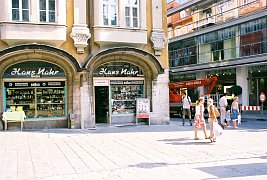 We eventually found the store and yes it did have the adapter we wanted.
It was not easy to find! Now we will go on a search for the Odeonsplatz.
We eventually found the store and yes it did have the adapter we wanted.
It was not easy to find! Now we will go on a search for the Odeonsplatz.
|
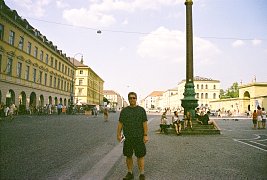 The Odeonsplatz is an Italinesque square.
Its features include the Feldherrnhal, the Theatiner Church, and the Hofgarten.
Until 1791 the Schwabinger Tor, which was built in 1391, stood at the Odeonsplatz. It was the
main gate connecting Munich with the old village Schwabing. In 1816, Ludwig I commissioned
Leo von Klenze with the planning and completing of all the main buildings around the
Odeonsplatz. Klenze was fascinated by the architecture of ancient Rome and the
renaissance. He made the square the focal point of two main streets, the Ludwigstrasse
and the Briennerstrasse.
The Odeonsplatz is an Italinesque square.
Its features include the Feldherrnhal, the Theatiner Church, and the Hofgarten.
Until 1791 the Schwabinger Tor, which was built in 1391, stood at the Odeonsplatz. It was the
main gate connecting Munich with the old village Schwabing. In 1816, Ludwig I commissioned
Leo von Klenze with the planning and completing of all the main buildings around the
Odeonsplatz. Klenze was fascinated by the architecture of ancient Rome and the
renaissance. He made the square the focal point of two main streets, the Ludwigstrasse
and the Briennerstrasse.
|
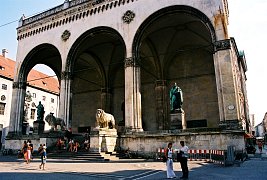
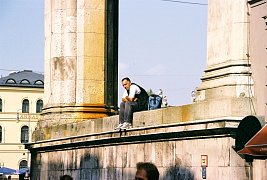 The building which catches the eye most is the Feldherrnhal,
which sometimes makes the Odeonplatz look like an Italian square.
The Feldherrnhall consists of three arches, with at the entrance two Bayern lions. The
building was designed in 1841 by Friedrich von Gärtner after the Loggia dei Lanzi in
Florence, Italy on request of Ludwig I in honor of Bayern generals. I believe that in
1923 during
the Beer Hall Putsch Hilter and his cohorts were coming down the street at the right or left
of the Feldherrnhall when they were fired on.
The building which catches the eye most is the Feldherrnhal,
which sometimes makes the Odeonplatz look like an Italian square.
The Feldherrnhall consists of three arches, with at the entrance two Bayern lions. The
building was designed in 1841 by Friedrich von Gärtner after the Loggia dei Lanzi in
Florence, Italy on request of Ludwig I in honor of Bayern generals. I believe that in
1923 during
the Beer Hall Putsch Hilter and his cohorts were coming down the street at the right or left
of the Feldherrnhall when they were fired on.
|
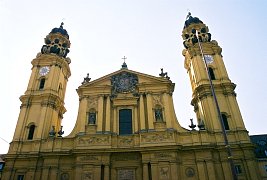
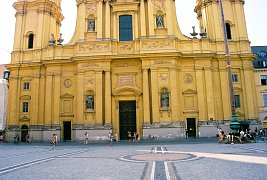 To the west of the Feldherrnhal is the copper-domed Theatinerkirche Basilica, which was built over the
years 1662-1768 in Italian high-baroque style. It was initially designed by Agostino Barelli who
patterned it after the San Andrea del Valle church in Rome
His successor, Enrico Zuccalli finished the 71 meters high dome in
1690 and added two towers, which originally weren't planned. The current facade
in late rococo style was only finished in 1768 by François Cuvilliés.
To the west of the Feldherrnhal is the copper-domed Theatinerkirche Basilica, which was built over the
years 1662-1768 in Italian high-baroque style. It was initially designed by Agostino Barelli who
patterned it after the San Andrea del Valle church in Rome
His successor, Enrico Zuccalli finished the 71 meters high dome in
1690 and added two towers, which originally weren't planned. The current facade
in late rococo style was only finished in 1768 by François Cuvilliés.
|
|
|
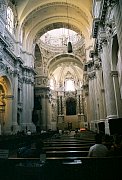
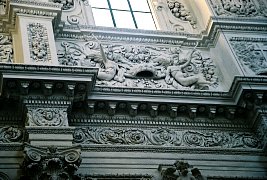
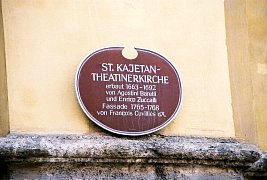 The inside of the church is a very vivid ivory color - it's beautiful.
The inside of the church is a very vivid ivory color - it's beautiful.
|



















